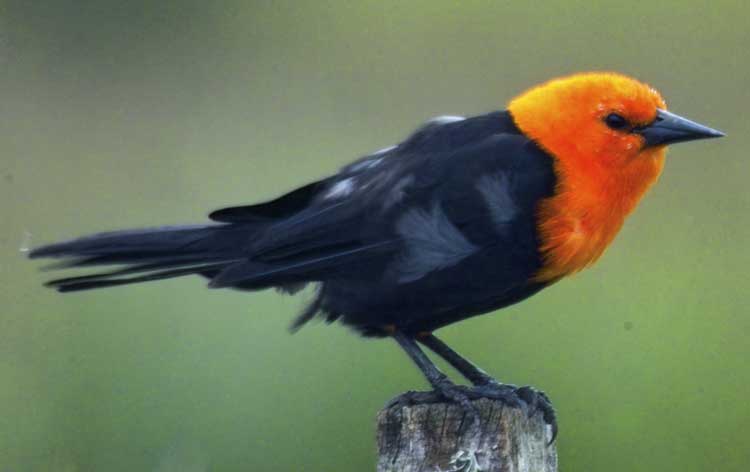
Amblyramphus holosericeus
Superregnum: Eukaryota
Cladus: Unikonta
Cladus: Opisthokonta
Cladus: Holozoa
Regnum: Animalia
Subregnum: Eumetazoa
Cladus: Bilateria
Cladus: Nephrozoa
Superphylum: Deuterostomia
Phylum: Chordata
Subphylum: Vertebrata
Infraphylum: Gnathostomata
Megaclassis: Osteichthyes
Cladus: Sarcopterygii
Cladus: Rhipidistia
Cladus: Tetrapodomorpha
Cladus: Eotetrapodiformes
Cladus: Elpistostegalia
Superclassis: Tetrapoda
Cladus: Reptiliomorpha
Cladus: Amniota
Classis: Reptilia
Cladus: Eureptilia
Cladus: Romeriida
Subclassis: Diapsida
Cladus: Sauria
Infraclassis: Archosauromorpha
Cladus: Crurotarsi
Divisio: Archosauria
Cladus: Avemetatarsalia
Cladus: Ornithodira
Subtaxon: Dinosauromorpha
Cladus: Dinosauriformes
Cladus: Dracohors
Cladus: Dinosauria
Ordo: Saurischia
Cladus: Eusaurischia
Subordo: Theropoda
Cladus: Neotheropoda
Cladus: Averostra
Cladus: Tetanurae
Cladus: Avetheropoda
Cladus: Coelurosauria
Cladus: Tyrannoraptora
Cladus: Maniraptoromorpha
Cladus: Maniraptoriformes
Cladus: Maniraptora
Cladus: Pennaraptora
Cladus: Paraves
Cladus: Eumaniraptora
Cladus: Avialae
Infraclassis: Aves
Cladus: Euavialae
Cladus: Avebrevicauda
Cladus: Pygostylia
Cladus: Ornithothoraces
Cladus: Ornithuromorpha
Cladus: Carinatae
Parvclassis: Neornithes
Cohors: Neognathae
Cladus: Neoaves
Cladus: Telluraves
Cladus: Australaves
Ordo: Passeriformes
Subordo: Passeri
Infraordo: Passerida
Superfamilia: Passeroidea
Familia: Icteridae
Genus: Amblyramphus
Species: Amblyramphus holosericeus
Name
Amblyramphus holosericeus (Scopoli, 1786)
Type locality: Antigue, Isle of Panay (Philippines), error; suggested islands of the delta of the Parana.
Synonyms
Xanthornus holosericeus (protonym)
References
Del.Flor.Faun.Insubr. p.88
Vernacular names
English: Scarlet-headed Blackbird
español: Federal
português do Brasil: cardeal-do-banhado
The scarlet-headed blackbird (Amblyramphus holosericeus) is an icterid found in the South American wetlands.
Description
This species is about 24 cm long. The bill is oddly shaped: long, slender, and very sharp, looking almost upturned. Adults of both sexes are described by their name. Juveniles have entirely black plumage; orange-red feathers first appear on their breast and throat, later spreading to the neck, head, and thighs. The song is given as "loud, clear, and melodic, a ringing 'cleer-cleer-clur, clulululu'." Calls are simpler but have a similar quality.[2]
Scarlet-headed blackbirds occur in pairs in large reed beds in Argentina, Paraguay, Uruguay and southern Brazil; Bolivia has an isolated population living at an altitudes of about 600 m. They often perch conspicuously on top of stems. They are uncommon, particularly away from the coast.[2]
They eat mainly fruit, supplementing it with seeds and invertebrates, especially insects. They use their bill as a hammer to open food items.[3]
Scarlet-headed blackbirds are monogamous, and territories are grouped together. The nest is an open cup placed in the crotch of a shrub or woven into vegetation, in which they lay two eggs.[3]
References
BirdLife International (2018). "Amblyramphus holosericeus". IUCN Red List of Threatened Species. 2018: e.T22724265A132029107. doi:10.2305/IUCN.UK.2018-2.RLTS.T22724265A132029107.en. Retrieved 12 November 2021.
Ridgely, Robert S.; Tudor, Guy (1989). The Birds of South America: The Oscine Passerines. University of Texas Press. p. 345. ISBN 0-292-70756-8. Retrieved 2007-02-19.
"Scarlet-headed blackbird". Meet the Animals. Toronto Zoo. Archived from the original on 2006-11-11. Retrieved 2007-02-19.
Retrieved from "http://en.wikipedia.org/"
All text is available under the terms of the GNU Free Documentation License

